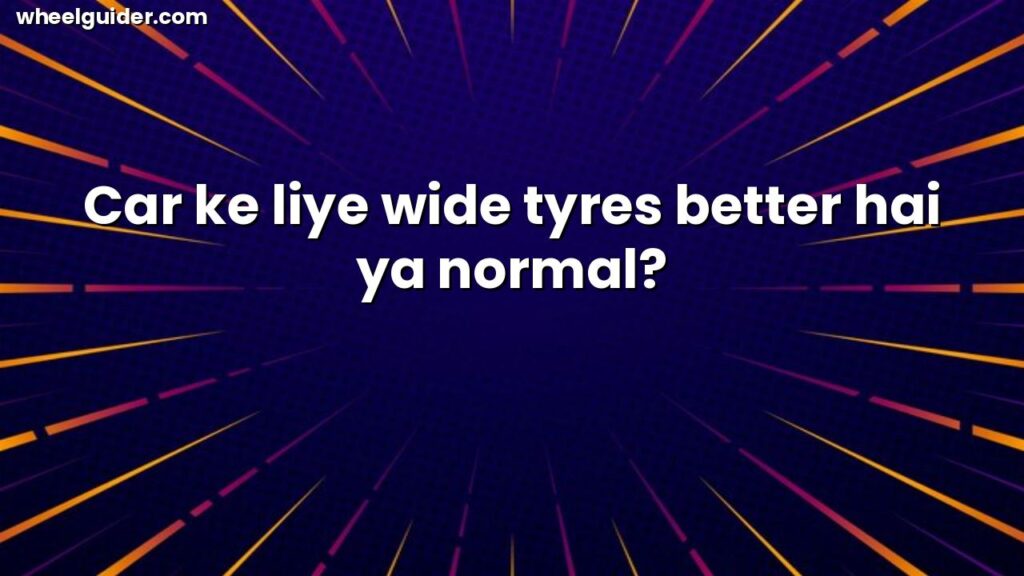So, you’re eyeing those sleek, low-profile tyres, aren’t you? They look *so* cool, giving your ride that slammed, sporty vibe. But before you rush to the tyre shop and *phatka* down your hard-earned cash, let’s chat. Are low-profile tyres all style and no substance? Are they a *jhatka* upgrade or a risky move? Let’s find out!
What are Low-Profile Tyres Anyway?
Think of it like this: your tyre has a sidewall – that rubbery bit between the rim and the tread. Low-profile tyres have a smaller sidewall compared to regular tyres. So, for the same wheel diameter, a low-profile tyre will have a much lower overall height. It’s like giving your car a super-stylish haircut!
Why the Hype?
The *main* attraction? Looks! Low-profile tyres instantly upgrade your car’s aesthetic. They make your wheels look bigger, giving your ride a more aggressive, sporty stance. It’s a simple change that makes a big visual difference. Think of it as adding a *tadka* of style to your four-wheeler.
The Stylish Side: Pros of Low-Profile Tyres
Okay, we’ve established that they look *bomb*. But are there any other benefits? Well, yes!
- Improved Handling: The lower profile means better road contact, leading to improved steering response and handling. You’ll feel more connected to the road, which is a *major* plus for driving enthusiasts.
- Enhanced Performance: Less sidewall flex means less energy is lost during acceleration and braking. This translates to quicker acceleration and shorter braking distances. It’s like your car got a *turbocharge* in performance, without actually having to add one!
- Sharper Cornering: The stiffer sidewall helps the tyre maintain its shape during cornering, resulting in better grip and more precise handling. It’s a *game-changer* for those who enjoy spirited driving.
The Risky Business: Cons of Low-Profile Tyres
Now for the not-so-glamorous side. While low-profile tyres look amazing, they do come with some downsides. Let’s be *real* here.
- Rough Ride: That smaller sidewall means less cushioning. Every bump, pothole, and crack in the road will be felt more intensely. Prepare for a less comfortable ride, especially on poorly maintained roads. It’s like driving on a *thali* of broken glass!
- Increased Risk of Damage: Low-profile tyres are more susceptible to damage from potholes, curbs, and other road hazards. A single pothole could lead to a costly repair or even a replacement tyre. This is a *serious* consideration.
- Higher Cost: Low-profile tyres are generally more expensive than standard tyres. The cost of replacement can also be a *major* hit to your wallet.
- Reduced Fuel Efficiency: The increased rolling resistance can slightly decrease your fuel economy. It’s not a huge difference, but something to keep in mind if you’re conscious about fuel consumption.
Real-Life Scenario: My Friend’s Low-Profile Woes
My friend Rohan, *yaar*, he went all in on low-profile tyres for his new car. Looked *super* cool initially, but he quickly realised the harsh reality. He was constantly worried about hitting potholes, and the ride quality was far from comfortable. Plus, he ended up replacing a tyre after hitting a particularly nasty pothole. The total cost? *Ouch*! That’s a *hard-hitting* lesson learned.
The Verdict: Stylish or Risky?
So, are low-profile tyres stylish *ya* risky? The answer, as with most things in life, is… it depends. If you prioritize looks and performance above comfort and practicality, and if you drive mostly on smooth roads, they might be a good fit. But if you regularly encounter rough roads, potholes are a common sight, and your budget is tight, then you might want to reconsider.
Things to Consider Before You Buy:
- Road Conditions: Do you drive mostly on smooth highways or rough, pothole-ridden streets?
- Driving Style: Are you a cautious driver or do you enjoy spirited driving?
- Budget: Can you afford the higher initial cost and potential repair expenses?
- Comfort Level: Are you willing to sacrifice comfort for style?
Ultimately, the decision is yours. Weigh the pros and cons carefully, consider your driving habits and road conditions, and choose what best suits your needs and budget. Don’t just follow the trend; make an informed choice! After all, a happy ride is a safe and comfortable ride, *hai na*?


